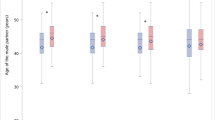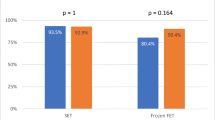Abstract
Purpose
To investigate the effect of sperm concentration, motility and advanced paternal age on reproductive outcomes.
Methods
A retrospective analysis of 1266 intracytoplasmic sperm injection (ICSI) cycles between 2013 and 2017. The cohort was divided into four groups according to semen concentration based on the WHO criteria (2010): group A (conc. <1 M/ml), group B (1 ≤ conc. <5 M/ml), group C (5 ≤ conc. < 15 M/ml) and the control group D (conc. ≥15 M/ml). The primary outcome investigated was the blastulation rate. Secondary outcomes were fertilization rate, top quality blastocyst formation rate and ongoing pregnancy rate.
Results
After adjustment for maternal age and number of oocytes recovered, a significant difference was observed between group A and group D on the rate of fertilized oocytes [66.7 (40.0–80.0) vs 75.0 (57.1–90.2), adjusted p < 0.001] and the blastocyst formation rate [50.0 (33.3–66.3) vs 55.6 (40.0–75.0), adjusted p < 0.05]. However, the male factor did not affect the top quality blastocyst formation rate nor the ongoing pregnancy rate. Considering the age of the male partner as confounding factor, at the increase of each year of age, a reduction of 0.3% on the fertilization rate was observed but no other outcome was impacted. A negative correlation was also observed between sperm motility and fertilization rate in the group with a motility <5%.
Conclusion
Male factor infertility and advanced paternal age may compromise fertilization and blastulation rates but not top quality blastocyst formation rate or the establishment of pregnancy in ICSI cycles.
Similar content being viewed by others
References
Schmidt L, Sobotka T, Bentzen JG, Nyboe Andersen A. Demographic and medical consequences of the postponement of parenthood. ESHRE reproduction and society task force. Hum Reprod Update. 2012;18(1):29–43.
Mercan R, Lanzendorf SE, Mayer J Jr, Nassar A, Muasher SJ, Oehninger S. The outcome of clinical pregnancies following intracytoplasmic sperm injection is not affected by semen quality. Andrologia. 1998;30(2):91–5.
Nagy ZP, Liu J, Joris H, Verheyen G, Tournaye H, Camus M, et al. The result of intracytoplasmic sperm injection is not related to any of the three basic sperm parameters. Hum Reprod. 1995;10(5):1123–9.
Oehninger S, Veeck L, Lanzendorf S, Maloney M, Toner J, Muasher S. Intracytoplasmic sperm injection: achievement of high pregnancy rates in couples with severe male factor infertility is dependent primarily upon female and not male factors. Fertil Steril. 1995;64(5):977–81.
Mansour RT, Aboulghar MA, Serour GI, Amin YM, Ramzi AM. The effect of sperm parameters on the outcome of intracytoplasmic sperm injection. Fertil Steril. 1995;64(5):982–6.
Mazzilli R, Cimadomo D, Vaiarelli A, Capalbo A, Dovere L, Alviggi E, et al. Effect of the male factor on the clinical outcome of intracytoplasmic sperm injection combined with preimplantation aneuploidy testing: observational longitudinal cohort study of 1,219 consecutive cycles. Fertil Steril. 2017;108(6):961–972.e3.
Chapuis A, Gala A, Ferrières-Hoa A, Mullet T, Bringer-Deutsch S, Vintejoux E, et al. Sperm quality and paternal age: effect on blastocyst formation and pregnancy rates. Basic Clin Androl. 2017;27:2.
Ferreira RC, Braga DP, Bonetti TC, Pasqualotto FF, Iaconelli A Jr, Borges E Jr. Negative influence of paternal age on clinical intracytoplasmic sperm injection cycle outcomes in oligozoospermic patients. Fertil Steril. 2010;93(6):1870–4.
Wu Y, Kang X, Zheng H, Liu H, Huang Q, Liu J. Effect of paternal age on reproductive outcomes of intracytoplasmic sperm injection. PLoS One. 2016;11(2):e0149867.
He Y, Liu H, Zheng H, Li L, Fu X, Liu J. Effect of early cumulus cells removal and early rescue ICSI on pregnancy outcomes in high-risk patients of fertilization failure. Gynecol Endocrinol. 2018;15:1–5.
World Health Organization. WHO Laboratory manual for the examination and processing of human semen. 5th ed. Geneva: World Health Organization; 2010.
Sánchez-Pozo MC, Mendiola J, Serrano M, Mozas J, Björndahl L, Menkveld R, et al. Special interest Group in Andrology of the European Society of Human Reproduction and Embriology. Proposal of guidelines for the appraisal of SEMen QUAlity studies (SEMQUA). Hum Reprod. 2013;28(1):10–21.
Corti L, Papaleo E, Pagliardini L, Rabellotti E, Molgora M, La Marca A, et al. Fresh blastocyst transfer as a clinical approach to overcome the detrimental effect of progesterone elevation at hCG triggering: a strategy in the context of the Italian law. Eur J Obstet Gynecol Reprod Biol. 2013;171(1):73–7.
Calzi F, Papaleo E, Rabellotti E, Ottolina J, Vailati S, Viganò P, et al. Exposure of embryos to oxygen at low concentration in a cleavage stage transfer program: reproductive outcomes in a time-series analysis. Clin Lab. 2012;58(9–10):997–1003.
Papaleo E, Ottolina J, Viganò P, Brigante C, Marsiglio E, De Michele F, et al. Deep pelvic endometriosis negatively affects ovarian reserve and the number of oocytes retrieved for in vitro fertilization. Acta Obstet Gynecol Scand. 2011;90:878–84.
Alpha Scientists in Reproductive Medicine and ESHRE Special Interest Group of Embryology. The Istanbul consensus workshop on embryo assessment: proceedings of an expert meeting. Hum Reprod. 2011;26(6):1270–83.
Practice Committee of American Society for Reproductive Medicine. Criteria for number of embryos to transfer: a committee opinion. Fertil Steril. 2013;99(1):44–6.
Ni W, Xiao S, Qiu X, Jin J, Pan C, Li Y, et al. Effect of sperm DNA fragmentation on clinical outcome of frozen-thawed embryo transfer and on blastocyst formation. PLoS One. 2014;9(4):e94956.
Alvarez Sedó C, Bilinski M, Lorenzi D, Uriondo H, Noblía F, Longobucco V, et al. Effect of sperm DNA fragmentation on embryo development: clinical and biological aspects. JBRA Assist Reprod. 2017;21(4):343–50.
Kodama H, Yamaguchi R, Fukuda J, Kasai H, Tanaka T. Increased oxidative deoxyribonucleic acid damage in the spermatozoa of infertile male patients. Fertil Steril. 1997;68(3):519–24.
Zini A, Bielecki R, Phang D, Zenzes MT. Correlations between two markers of sperm DNA integrity, DNA denaturation and DNA fragmentation, in fertile and infertile men. Fertil Steril. 2001;75(4):674–7.
Derijck AA, Van der Heijden GW, Ramos L, Giele M, Kremer JA, De Boer P. Motile human normozoospermic and oligozoospermic semen samples show a difference in double-strand DNA break incidence. Hum Reprod. 2007;22(9):2368–76.
Gawecka JE, Marh J, Ortega M, Yamauchi Y, Ward MA, Ward WS. Mouse zygotes respond to severe sperm DNA damage by delaying paternal DNA replication and embryonic development. PLoS One. 2013;8(2):e56385.
Høst E, Lindenberg S, Smidt-Jensen S. DNA strand breaks in human spermatozoa: correlation with fertilization in vitro in oligozoospermic men and in men with unexplained infertility. Acta Obstet Gynecol Scand. 2000;79(3):189–93.
Borges E Jr, Setti AS, Braga DP, Figueira RC, Iaconelli A Jr. Total motile sperm count has a superior predictive value over the WHO 2010 cut-off values for the outcomes of intracytoplasmic sperm injection cycles. Andrology. 2016;4(5):880–6.
Zheng J, Lu Y, Qu X, Wang P, Zhao L, Gao M, et al. Decreased sperm motility retarded ICSI fertilization rate in severe Oligozoospermia but good-quality embryo transfer had achieved the prospective clinical outcomes. PLoS One. 2016;11(10):e0165684.
Tsai YR, Lan KC, Kung FT, Lin PY, Chiang HJ, Lin YJ, et al. The effect of advanced paternal age on the outcomes of assisted reproductive techniques among patients with azoospermia using cryopreserved testicular spermatozoa. Taiwan J Obstet Gynecol. 2013;52(3):351–5.
Beguería R, García D, Obradors A, Poisot F, Vassena R, Vernaeve V. Paternal age and assisted reproductive outcomes in ICSI donor oocytes: is there an effect of older fathers? Hum Reprod. 2014;29(10):2114–22.
Luna M, Finkler E, Barritt J, Bar-Chama N, Sandler B, Copperman AB, et al. Paternal age and assisted reproductive technology outcome in ovum recipients. Fertil Steril. 2009;92(5):1772–5.
McPherson NO, Zander-Fox D, Vincent AD, Lane M. Combined advanced parental age has an additive negative effect on live birth rates-data from 4057 first IVF/ICSI cycles. J Assist Reprod Genet. 2018;35(2):279–87.
Zhu Y, Wu QF, Zhou XJ, Xin CL, Ling G, Lu GX. ICSI improves fertilization in isolated teratozoospermic men: a study with strictly controlled external factors and WHO-5 standard. Syst Biol Reprod Med. 2013;59(1):21–6.
French DB, Sabanegh ES Jr, Goldfarb J, Desai N. Does severe teratozoospermia affect blastocyst formation, live birth rate, and other clinical outcome parameters in ICSI cycles? Fertil Steril. 2010;93(4):1097–103.
Author information
Authors and Affiliations
Corresponding author
Ethics declarations
Conflict of interest
E.P. reports consultancies with MSD, Merck-Serono, Ferring, and IBSA Institut Biochimique SA; grants from MSD, Merck-Serono, Ferring, IBSA Institut Biochimique SA and FINOX; honoraria from MSD, Merck-Serono, and Ferring; and travel expenses paid by MSD, Merck-Serono, Ferring, and IBSA Institut Biochimique SA. All the other authors declare no conflict of interest.
Ethical approval
All procedures performed in studies involving human participants were in accordance with the ethical standards of the institutional and/or national research committee and with the 1964 Helsinki declaration and its later amendments or comparable ethical standards.
Electronic supplementary material
Supplementary Fig. 1
Representation of the dimension reduction obtained by Principal Component Analysis to resume the complexity of information related to the female partner. PC Principal Component. (PDF 137 kb)
Rights and permissions
About this article
Cite this article
Bartolacci, A., Pagliardini, L., Makieva, S. et al. Abnormal sperm concentration and motility as well as advanced paternal age compromise early embryonic development but not pregnancy outcomes: a retrospective study of 1266 ICSI cycles. J Assist Reprod Genet 35, 1897–1903 (2018). https://doi.org/10.1007/s10815-018-1256-8
Received:
Accepted:
Published:
Issue Date:
DOI: https://doi.org/10.1007/s10815-018-1256-8




